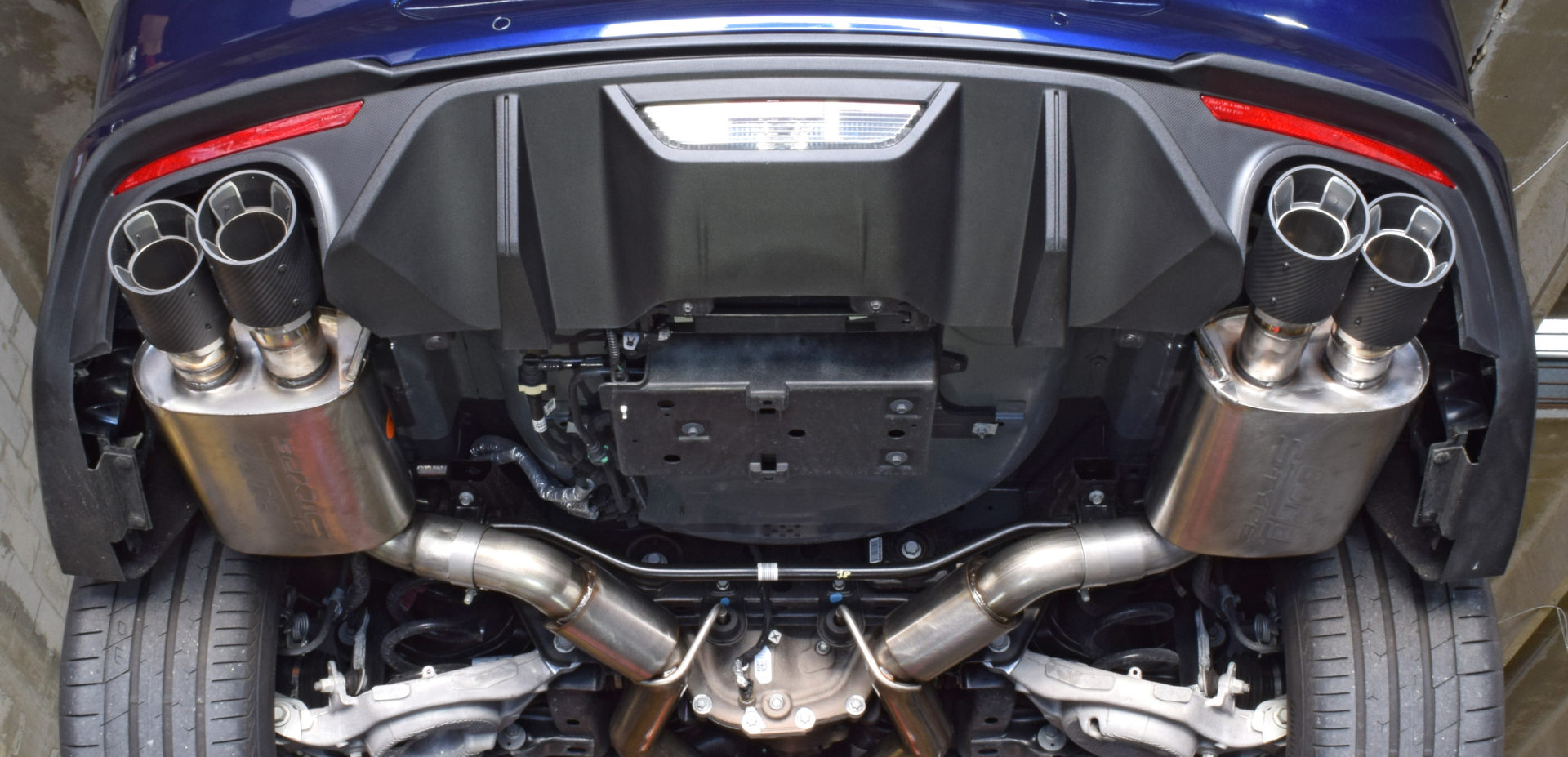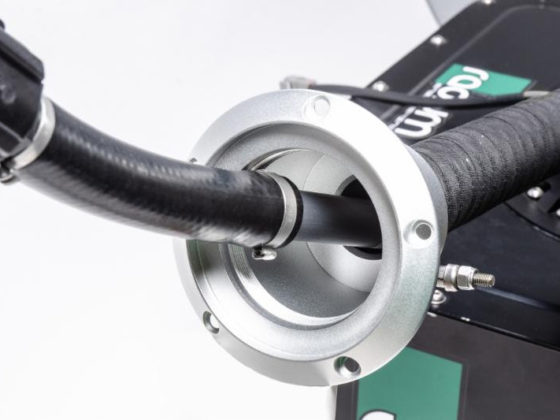
For fun here’s the stock 2018 GT (blue) compared to the Borla (red) and then overlaid with a stock GT350 (orange). The Borla-equipped 2018 GTPP matches the GT350 from 3,500-5,800rpm but then the GT350 takes off and has a 32whp advantage by 6,900rpm before peaking out at 36whp. However, for street driving, the Borla-equipped 2018 GT dominates with a crushing 77lb-ft of torque at 2,500rpm and at best, a 58lb-ft advantage at 2,900rpm. Anything below 3,500rpm the GT350 is noticeably slower. For daily driving, the Borla-equipped 2018 GT is arguably better if you don’t consider the unique Flat Plane Crank howl of the 5.2L Voodoo, but the 3-valve pitch of the Borla makes it a very tough subjective call.
STREET REVIEW
On the road, the Borla S-Type exhaust is fantastic. I personally find most aftermarket exhausts for Mustangs too loud to live with every day. This is a highly personal preference and when I was younger, I enjoyed being obnoxious with a straight-piped Miata, so I get it. But for my daily drivers, I am a bit more critical in finding the balance between not having drone, having a quality pitch in the sound, and being enjoyably loud when revving it out, while retaining the ability to hold a conversation when my phone is connected to the car’s Sync-3. This is why I tend to favor going with the quietest model exhausts for Mustangs, which I have yet to hear one that I thought was too quiet and not worth the money. As you get rid of the sound muffling cats and then go to long tube headers, it’s difficult to find a tolerable exhaust package that does not retain the large and power-sucking factory resonator.
During cold start, the exhaust bellows an aggressive and slightly loud note as the engine keeps the revs high and adjusts the timing and fuel to warm up the cats quickly to save the environment. After a few seconds it drops down to the normal 650rpm idle where it is not much louder than stock, but the dep pitch and gargle from the exhaust hints that this is not just another car in the parking lot. I’ve received a compliment by the local Sheriff department at a gas station that the exhaust “sure does not sound slow”. He was in an undercover Challenger SRT, so I took it as a compliment since he had a grin on his face and was unlikely ‘stuck’ driving that car.

On the road, there is zero drone. The exhaust is very subdued at highway speeds and even during mild acceleration that usually causes drone or at least a big increase in deep pitch from most exhausts. This makes livability quite good. Throttle response is greatly improved and the 17-33lb-ft increase in torque below 4,000rpm transforms the car that is now far more eager to drive. I can’t stress how much of a difference this torque makes in the low-end makes to daily driving, all without sacrificing anything up top, but rather boosting high RPM power as well.
The low-RPM torque increase was huge, but the mid-RPM is where the Coyote starts to come alive. As the RPMs increase so does the power, noise, and excitement. There’s something about the combination of the new Gen-3 Coyote and this Borla exhaust that virtually eliminates the trumpeting rasp that’s so quintessential “Coyote-Powered Mustang” and gives the exhaust a smoother, more refined, classic V8 sound that reminds me more of the older 3V 4.6L Mustangs and even the 4V “Cammer” motors. While the raspy Coyote is a unique sound in and of itself, I personally prefer the noise that comes from those older V8s (and I’m not alone in this preference) even though they don’t hold a candle to the newer Coyote in terms of power or efficiency. Somehow the Borla S-Type exhaust creates that same beautiful sound quality out of the new Gen-3 Coyote, while stomping the performance gains of cat-back exhausts in previous generation Coyote engines.
But I digress. As you go full throttle and are climbing through the mid-range of the powerband, the smooth, deep roar kicks it up an octave to and equally refined howl as a 9lb-ft of torque increase pushes the 5.0L above 400lb-ft of torque. As the RPMs rocket toward redline, the pitch of the exhaust continues to raise with an almost European scream that is enjoyable but nowhere near obnoxiously loud that would give you second thoughts on wringing it out due to unwanted attention. Torque increases at the top end to 15lb-ft at 6,500rpm giving a nice 19whp bump in power that helps the engine pull noticeably harder to redline, which is very welcome yet surprising to see given the substantial gains down low.
Overall, we are still in a bit of disbelief in the performance gains. 33lb-ft of torque at 2,400rpm and 19whp at 6,500rpm are significant on two extremes of the RPM band. These were also the averages, and there were pulls that made fractionally more power than that. The humidity, atmospheric pressure and SAE correction were all identical and temperatures were within 1.5*F on the same day. It’s hard to ask for much better testing than that, and our disbelief is eliminated every time we are behind the wheel and feel the massive gains across the board in addition to what may be one of my favorite sounding modern Mustang exhaust systems. A 30lb weight savings, significant torque and power increases, and a great sounding exhaust that that brings out the enjoyment of performance driving, yet retains livable day after day, and has received far more compliments from random people on the street than any other car/exhaust combination I’ve ever had in the past, just might make this the most impressive cat-back exhaust system that I’ve ever done.
Sources




14 comments
Really happy with the harmonics produced by my Borla Cat-back. In my youth, I once enjoyed a much louder exhaust, but now that I am much wiser, I relish a subdued but distinct aural character.
It’s interesting to note, that the exhaust flow sounds much better when paired with 4-2-1 headers, as well. There seems to be almost no downsides to a properly designed after-market exhaust system. At least, I haven’t found any.
Great stuff Billy. Fascinating to see the dyno difference between 3rd and 4th gear. And the new Coyote engine is really impressive.
Wow, the new Coyote kicks ass. I didn’t like its lack of torque before. The base engine design is excellent including the head and ports, do you know what they did to improve it? Intake manifold? That was another weakness of the engine as we made huge gains by changing that with our white project car.
The Coyote is kind of like two K24s bolted together. It’s designed for more RPM and does not have the low RPM torque of a larger stroke, larger displacement pushrod engine.
Do you have any questions beyond what was said in the second paragraph?
I wouldn’t call the 2015-17 intake manifold a “weakness”. It’s designed for packaging and more low end torque for a street driven car. The CobraJet you put on sacrifices a little in the low and mid-range for big gains at high RPM.
My Power Pack 1-3 article highlights this quite well and some people even put longer-runner F150 manifolds on for even more low-end torque for daily driving, at the cost of peak power and power up top.
I know that people are using the latest manifold on the older engine. I wonder is it is better than the Cobra Jet manifold where we saw gains across the board.
The 2018 manifold took what was learned on the GT350 manifold and has runners slightly longer & smaller than the GT350 to boost low-mid torque, while optimizing the powerband of the 2018 GT’s lower (than GT350) redline.
The 2018 manifold’s runners are shorter & larger than a stock 2015-17 manifold, so it’s actually a middle ground between them, while delivering gains across the board over the 2015-17 manifold. Due to the fact that most GTs aren’t revved to the GT350’s 8,250rpm redline, and because it has more low end torque, and (mostly) because its ALOT cheaper, the 2018 manifold is more popular than the GT350 manifold on 2015-17 cars.
In regards to the CobraJet manifold you put on: With optimized tuning for each and only changing the manifolds themselves, the stock 2015-17 manifold should have more low-mid torque than the Cobrajet due to the longer and smaller runners, vs the short, straight runners on the CJ. From 5,000rpm+ the CobraJet is similar then slightly better than the GT350 manifold at high RPM (and WAY better than the 2015-17 manifold at high RPM).
Since you’ve driven your fair share of Fords, what’s your take on the Mustang GT convertible? What does it lose dynamically?
Great article Billy! As usual, lots of details and your expertise in this stuff makes it a great read. I have only one thing to point out: Comparing the dynos of the stock 18 vs ‘16 PP3 and the 2-3whp difference, keep in mind that the 16 was dyno’d in 4th (not 1:1) which you said Ken (Palm Beach) said, in his experience, would read “10-15 whp” low. You gained 7whp from the exhaust on the 16 so the actual peak power on this dyno would be 417-422whp (~407whp stock + 10-15 from the loss using 4th). The 18 cutoff 100rpm below Fords published power peak (7K), so it is also low but it’s on that “Mesa” of power so prob not that much more to get. So it looks like the 16 PP3 either equals or just slightly exceeds the stock 2018.
BUT – that’s peak power. The massive mid range gains plus “Mesa” near the peak means I’ll bet the area under the curve is better for the stock 2018. And, as you show, make any minor mod to the 18 and you’re way above even PP3 for the 15-17. I wish Ford hadn’t killed some of the manual’s potential by using such tall gearing in tinge interest of mileage.
Thank you for the compliments. I was waiting for someone as analytical as you to make that connection and point that out. I was debating on whether to add another layer of analysis to ‘properly’ explain what you just noticed but felt 99% of the readers wouldn’t catch it and doing so would just muddy the reading with too much analysis. It just goes to show that it is extremely difficult to properly analyze and compare Dyno data, but I try to provide as much consistency and information for people to make educated decisions. Congrats on being the 1%.
Thanks for replying, and I agree with your rationale for not “muddying the waters”. Thanks again for the article and please do keep up the good work! You’re a rarity online and I know a lot of us appreciate it.
Borla also makes what appears to be a lower restriction cross-over pipe. I wonder how much more power, if any, that might free up.
https://www.borla.com/products/mustang_gt_xpipe_part__60662.html
A few months ago, I installed the borla switchfire crossover pipe on my ’15 (linked in my reply from over a year ago, above). It completely changed the tone of my gen2 coyote, and made me fall in love with the car all over again. The mufflers were the larger-boxed flowmaster FlowFX, which is a quiet straight through design. Combined, the tone has a satisfying gurgle at low revs and a screaming Euro howl towards redline.
I noticed a significant tone change dependent on whether I ran it stock, or with a steeda flash tune. The steeda tune gives it a harder “edge,” with a distinct rasp; lovely to me—de gustibus and all that.
There was a noticeable boost in low end torque, which made the rear end squirmy. Last week, I took that mid-pipe off: the drop in low end torque was immediately apparent.
I’ve saved the pipe for the ’20 Mustang GT I’m picking up next week. I might delay putting it on, because of the much improved sound of the gen3 — will swap it over once the honeymoon phase wears off.
Excellent review! Question: you say this is Borla part #140745CF, which HAS VALVES and is for GTs with active exhaust. Were you able to retro-fit a nonactive with active? Or, is the proper part # 140745CF?
In previous reply I meant to say your part # is 140742CF